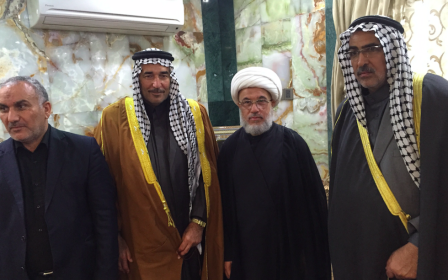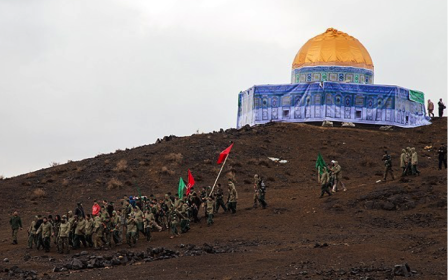13 million Shia pilgrims descend on Karbala for Arbaeen

Old men push wives in wheelchairs. Mothers manoeuvre overloaded baby buggies. The Iraqis among them mainly come on foot, in long columns beside the main highway, southwards from Baghdad, and westwards from the string of Shia towns that stretches from Basra to Karbala.
People from 40 countries, however, are also gathering on Wednesday in the southern Iraqi city of Karbala to mark Arbaeen, the 40th day of the mourning for the Prophet Muhammad’s grandson, Imam Hussein.
Women, all wearing the full black abaya, carry their spare clothes in backpacks or bags perched on the heads. Many young men carry tents so that they can sleep on the streets around the shrine of Imam Hussein. Hundreds spend the night out in the open, even though night-time temperatures fall to zero at this time of the year. Street signs are put up in Farsi as well as Arabic for the hundreds of thousands of Iranians among the crowd.
Arbaeen may be the largest pilgrimage in the world. An estimated 13 million Shia Muslims have made their way to the southern Iraqi city - four times the number who make the annual Hajj to Mecca where numbers are limited for security reasons. And even that figure is an estimate, since no one can count the vast mass of people and there is no requirement for pilgrims to register.
Yet it is a pilgrimage largely overlooked by outsiders in what some Karbala officials say is "typical neglect of anything to do with Shia Muslims".
For at least two weeks, the pilgrims have been arriving in the city, with tens of thousands coming before the actual day of Arbaeen in order to have a chance to touch the gilded grille that surrounds Hussein’s tomb and slip messages through the bars. Occasionally, a group of chanting men appears, carrying round the shrine a black-draped coffin of a fighter killed in the battles against the Islamic State (IS) group.
Security is heavy, with checkpoints throughout the centre of Karbala where people undergo body searches. It appears to be working. Since IS came to prominence two years ago, and in spite of constant clashes between the group and Shia militias in other parts of Iraq, there have been no car bombs or suicide attacks in the holy city.
The huge Arbaeen pilgrimage is in part a consequence of the massive wealth of the Imam Hussein shrine and its counterpart, the Imam Ali shrine in Najaf, which are able to finance the construction and upkeep of hundreds of large carpeted tents along the route, where people can rest or sleep for a few hours or the whole night. Thousands of others sleep in “husseiniyas,” the Islamic centres where cultural and other events are normally held during the rest of the year.
The Iraqi government is facing a tight revenue crunch as a result of the halving of the world oil price over the last year. But the shrines in Karbala and Najaf appear to be overflowing with funds, which enable them to provide free food, water and blankets to pilgrims on the journey and in Karbala itself. The Imam Hussein shrine employs as many as 13,000 staff, spread across 42 departments from catering and cleaning to hotels and public relations.
Thanks to donations from the faithful, as well as vows made by richer Shia Muslims who promise large sums of money if certain wishes are fulfilled - such as recovery from illness or finding a suitable son-in-law, the shrines have enough money to enlarge the pilgrim sites. In Karbala, a network of underground passages and escalators is just about to open that will bring the more important pilgrims and officials to the shrine without having to inch their way through the enormous throng.
The open courtyard of the shrine itself was recently roofed over, allowing for thousands to sit or kneel on carpets away from direct sunlight. In Najaf, another holy city for Shias some 50 kilometres south, building-work is nearing completion for a new extension which will more than double the amount of enclosed space.
Beyond the impressive logistics of the annual pilgrimage the huge size of the crowds who attend it is a tribute to the spiritual force of Imam Hussein’s pious life and martyrdom, as Shias see it, in the struggle over who should lead Muslims after Prophet Muhammad’s death. Arbaeen (literally, the number 40) comes 40 days after Ashura, the anniversary of the day when Hussein and 72 companions, including women and children, were confronted by 4,000 troops under Yazid I, the second Caliph of the Umayyad Caliphate. After eight days of being urged to surrender, Hussein and his men were brutally killed. The women were taken on a forced march into captivity.
Hussein was beheaded after pronouncing the words which many Shia have taken to heart: “Death with dignity is better than a life of humiliation". Since then, he has been seen as a hero of resistance to tyranny, injustice and inequality, and a role model for Shias who have traditionally been less powerful and less wealthy in Muslim societies. As Karbala clerics put it, Imam Hussein is "a symbol of moderate Islam".
Internally Displaced Sunnis
In addition to the pilgrims, Karbala is home to a group who will stay for much longer than the period of Arbaeen. These are people who have fled from towns and villages occupied by IS in Anbar province and the Mosul region. Many are Sunnis, and Shia officials say they are proud they feel safer among Shias.
"We have 1,194 displaced families which means around 8,000 people," Ahmed Yas, the supervisor of a sprawling trailer-park that has been established on the road between Najaf and Karbala, told Middle East Eye.
Financed by the World Food Programme and UNICEF, as well as the Iraqi Ministry for Refugees and the shrines, the camp offers every family a two-bedroom caravan with kitchen and bathroom and a cash card from which they can draw two million dinars ($1,666).
But the camp still lacks desks and chairs for the caravans set aside for a primary and a secondary school. There are enough teachers among the displaced families to staff them, but without furniture the schools cannot begin. As a result, children run around aimlessly between the caravans even though it is term-time.
“We lived in the centre of Fallujah but left when the terrorists took our houses two years ago," Ismail Jassem Mohammad, 61, told MEE.
"One of my sons was a police officer but Daesh [IS] killed him, so we are looking after two orphaned children now. Daesh won’t let other people leave. They keep them as human shields.” For their first months in Karbala, Mohammad said his family lived in "husseiniyas," but moved out when the caravan camp opened.
Like several Iraqi tribes, his tribe - the Masud - has Shia and Sunni members, some of whom are spread across the Karbala area. “Karbala is safe. Our tribe is here,” he said.
Ahmed Abdul Aziz, a 19-year-old Sunni, also escaped from Fallujah some 30 kilometres west of Baghdad, with his parents and siblings. With 11 in the family, including wives of older brothers, they were allocated two caravans. “We heard Daesh was coming and we left before they took over,” he said.
Neither he nor his elderly Sunni neighbour from Fallujah, Ismail Jassem Mohammad, said they had any hope of soon seeing IS defeated. They fear they will still be living in caravans when the next Arbaeen comes round.
Middle East Eye propose une couverture et une analyse indépendantes et incomparables du Moyen-Orient, de l’Afrique du Nord et d’autres régions du monde. Pour en savoir plus sur la reprise de ce contenu et les frais qui s’appliquent, veuillez remplir ce formulaire [en anglais]. Pour en savoir plus sur MEE, cliquez ici [en anglais].





